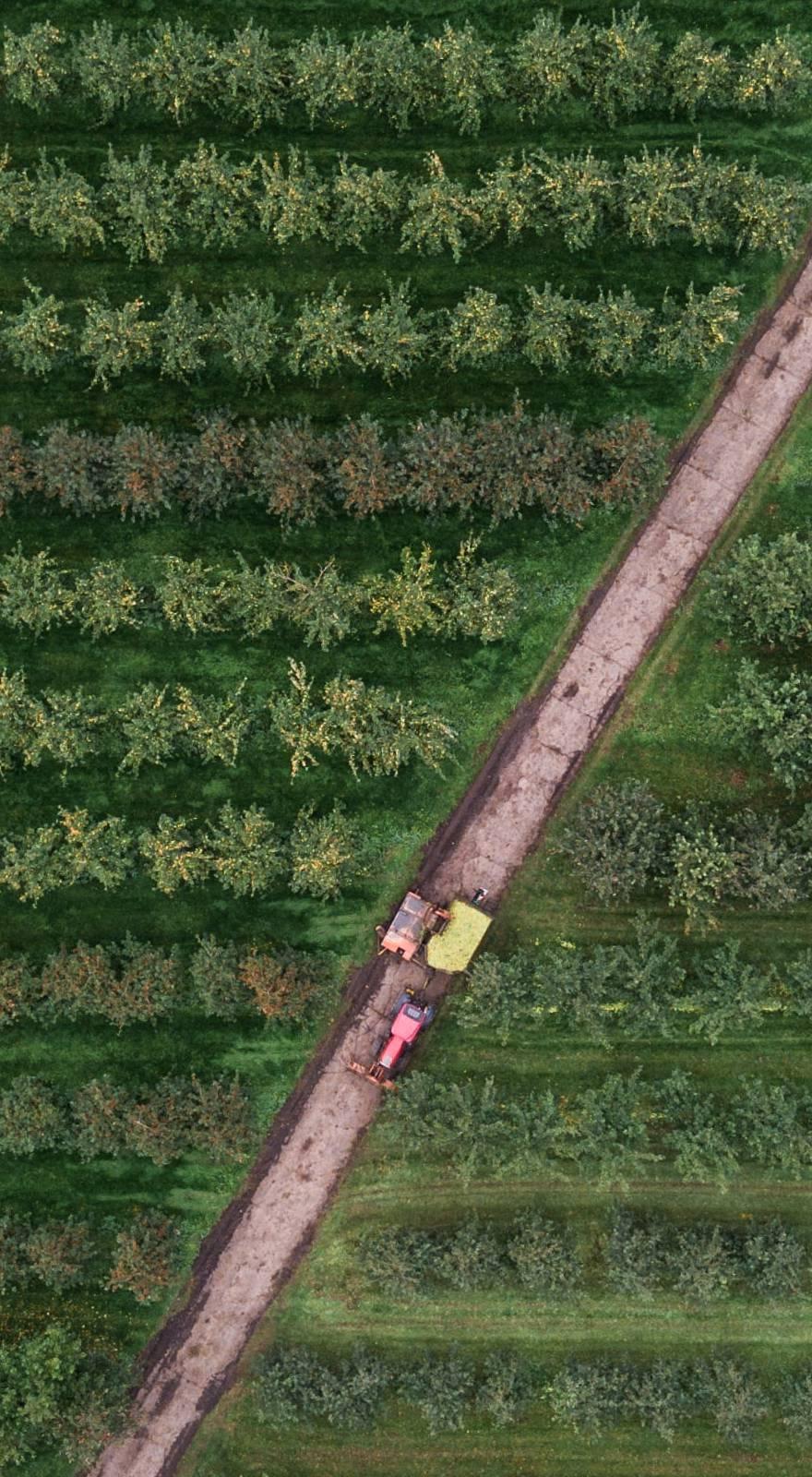Knowde Enhanced TDS
Identification & Functionality
- Agrochemical Functions
- Technologies
- Active Ingredients
Sodium Tetraborohydrate Decahydrate 0.99% Other Ingredients 99.01% Total 100.00%
Features & Benefits
- Product Highlights
- PREV-AM has been proven as an effective control for a wide spectrum of insects, mites and fungi.
- This powerful contact pesticide can be used alone for quick knockdown or tank-mixed with other pesticides as a part of your resistance management program.
- PREV-AM is the crop-friendly 3-in-1 pesticide that is ideal for use throughout the season for treatment of sudden outbreaks, population explosions and as a pre-harvest, clean-up spray.
- With PREV-AM there is no need for additional adjuvants due to the superior wetting and spreading characteristics that allow it to move into hard-to-reach areas and help prevent run-off.
- Either alone or mixed with other pesticides, PREV-AM delivers control you can count on.
Applications & Uses
- Markets
- Applications
- Applicable Crop
- Application Technique
- Fungicide Target Species
- Insecticide Target Species
- PREV-AM as a Resistance Management and IPM Tool
Adding PREV-AM to a spray program can extend the useful life of insecticides and pesticides that may be susceptible to the development of resistance. PREV-AM can be a valuable addition to insect and disease management spray programs. Its unique physical mode of action makes resistance development highly unlikely. PREV-AM can either replace application(s) of a susceptible pesticide or be added as an additional application in the spray rotation.
The quick knockdown of PREV-AM makes it a great addition to an IPM program. An application can be timed to control insects and diseases only when they reach the economic threshold, and because it is a contact pesticide and has no residual activity, PREV-AM applications can be made to avoid impacting beneficial.
- Recommended Use Guidelines
- Use 0.4% to 0.8% PREV-AM by volume (50 - 100 oz. per 100 gal. tank-mix solution).
- Direct spray to ensure maximum coverage of the entire plant.
- Tank mix with the appropriate residual materials if extended control of target pests is needed.
- Use PREV-AM prior to harvest to clean up insect and disease infestations. It delivers quick knockdown and is exempt from Maximum Residue Level (MRL) tolerances.
- Always read and follow label directions.
- Dilution & Mixing Instruction
Add PREV-AM® to water for the following concentrations:
To Make a: PREV-AM® (fl.oz) Water (Gallons) 0.004% (ai) Concentration (0.4% PREV-AM® in Water) 2.5 5 10 20 20 40 50 100
To Make a: PREV-AM® (fl.oz) Water (Gallons) 0.008% (ai) Concentration (0.8% PREV-AM® in Water) 5 5 10 10 20 20 40 40 100 100 - Spray Drift Management
- Wind Speed - Only apply this product if the wind direction favors on-target deposition. Do not apply at wind speeds greater than 15 mph at the application site
- Temperature Inversions - Do not make aerial or ground applications into temperature inversions. Inversions are characterized by stable air and increasing temperatures with height above the ground. Mist or fog may indicate the presence of an inversion in humid areas. The applicator may detect the presence of an inversion by producing smoke and observing a smoke layer near the ground surface. If applying at wind speeds less than 3 mph, the applicator must determine if a) conditions of temperature inversion exist, or b) stable atmospheric conditions exist at or below nozzle height. Do not make applications in areas of temperature inversions or stable atmospheric conditions.
- Droplet Size - Apply as a medium or coarser spray and the minimum volume mean diameter (VMD) for spinning atomizer nozzles. In conditions of low humidity and high temperatures, applicators should use coarser droplet size.
- Ground Application - Apply using a nozzle height of no more than 4 feet above the ground or crop canopy. Applications must be consistent with the limitations for wind speed, temperature inversions, and droplet size indicated above
- Airblast Application - For airblast application, turn off outward-pointing nozzles at row ends and when spraying the outer row. To minimize spray loss over the top in orchard applications, the spray must be directed into the canopy. Applications must be consistent with the limitations for wind speed, temperature inversions, and droplet size indicated above.
- Aerial Application (except CA) - Applications must be consistent with the limitations for wind speed, temperature inversions, and droplet size indicated above.
- Release Height - The spray boom should be mounted on the aircraft to minimize drift caused by wingtip or rotor vortices. The spray must be released at the lowest height consistent with pest control and flight safety. Do not release spray at a height greater than 10 feet above the crop canopy unless a greater height is required for aircraft safety
- Boom Length - The boom length must not exceed 75% of the wingspan or 80% of the rotor blade diameter. Flight speed and nozzle orientation must be considered in determining droplet size.
- Swath Adjustment - When applications are made with a cross-wind, the swath will be displaced downwind. The applicator must compensate for this displacement at the downwind edge of the application area by adjusting the path of the aircraft upwind. Leave at least one swath unsprayed at the downwind edge of the treated field.
- Directions For Applications
General Application Rates
- Row Crops - Apply in a minimum of 10 gallons per acre
- Trees & Vines - Apply in a minimum of 25 gallons per acre
- All other Ag crops - Apply in a minimum of 20 gallons per acre
- Turf - Use I to 2 gallons per 1000 square feet
- Outdoor, Nursery, and Greenhouse Plants - Apply in a minimum of 20 gallons per acre
Aerial, Ultra-Low Volumes and Electrostatic Spray Equipment
Aircraft, Ultra Low Volume and Electrostatic Equipment (All Crops) - Apply at 100 fl. oz. per 100 gallons of water (0.008% a.i. concentration) up to a maximum amount of 32 fl. oz. per acre application in a minimum of 2 gallons per acre and a maximum of 20 gallons per acre.
- PREV-AM use as an Insecticide and Miticide
Insects and mites are protected by a water repellent layer that loses its effectiveness when contacted by a PREV-AM application. This allows the active ingredient to penetrate and destroy the soft, living tissues underneath. The insects/mites are then exposed to the loss of body fluids, causing death. Flying insects experience loss of the protective coverings and tension in the wings, making them unable to fly. Additionally, water repellent hairs protecting the flexing points in insects lose their effectiveness, allowing PREV-AM to penetrate into their susceptible body parts, which are then destroyed. On some insects and mites the ultra low surface tension of PREV-AM allows an influx into the respiratory organs, causing internal suffocation.
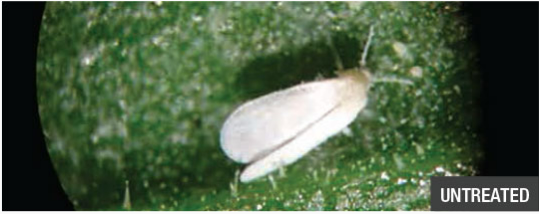
Whitefly, and other insects with waxy wings, are very vulnerable to PREV-AM.
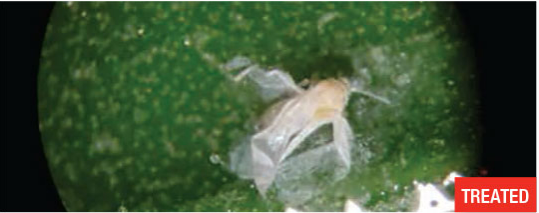
After just a few minutes, a 0.4% application of PREV-AM has destroyed the wings of this whitefly.
- PREV-AM Use as a Fungicide
The PREV-AM solution wets the protective membranes of the superficial fungal mycelia (hyphae) and spores, allowing the active ingredient to penetrate and destroy the living tissues underneath. This exposes the organism to the drying effect of the atmosphere and causes collapse within 2 to 24 hours. Plant tissue damaged by the fungus may also dry out and prevent further spread of infection, but healthy tissue is not affected at the recommended application rate.
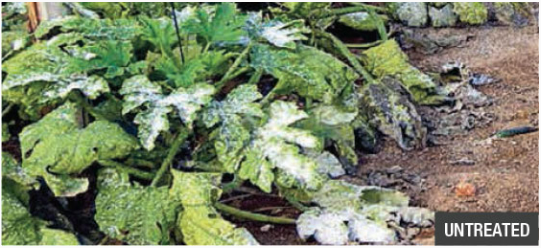
Cucurbits treated with eight applications of a 10% ciproconazol solution to eradicate a serious powdery mildew infestation, showing hardly any signs of improvement.
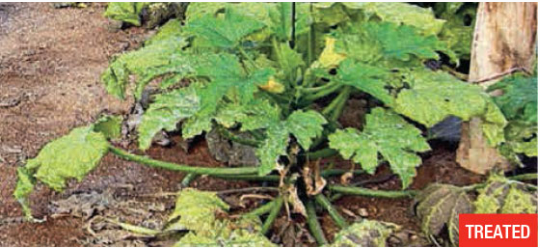
A row of cucurbits treated once with PREV-AM at 0.4% concentration as a curative measure. Recommendation: Use PREV-AM at 0.4% concentration throughout season to effectively prevent disease outbreaks.
Properties
- Active Ingredient
| Value | Units | Test Method / Conditions | |
| Active Ingredient | 0.084 | lb/gal | — |
Storage & Handling
- Pesticide Storage
Do not contaminate water, food, or feed by storage and disposal. Always store pesticides in the original container. Store pesticides away from food, pet food, feed, seed, fertilizers, and veterinary supplies. Keep pesticide storage areas clean. Clean up any spills promptly. In case of spill or leak on floor or paved surfaces, soak up with sand, earth, or synthetic absorbent. Remove to chemical waste area.
- Pesticide Disposal
Wastes resulting from the use of this product must be disposed of on site or at an approved waste disposal facility.
- Container Handling
For containers equal to or less than 5 Gallons (non-refillable container), do not reuse or refill this container. Clean container promptly after emptying. Triple rinse as follows: Empty the remaining contents into application equipment or a mix tank and drain for 10 seconds after the flow begins to drip. Fill the container 1/4 full with water and recap. Shake for 10 seconds. Pour rinsate into application equipment or a mix tank or store rinsate for later use or disposal. Drain for 10 seconds after the flow begins to drip. Repeat this procedure two more times. Offer for recycling if available or puncture and dispose of in a sanitary landfill, or by incineration, or, if allowed by state and local authorities, by burning. If burned, stay out of smoke.
For Nonrefillable Container (greater than 5 Gallons), do not reuse or refill this container. Triple rinse container (or equivalent) promptly after emptying. Triple rinse as follows: Empty the remaining contents into application equipment or a mix tank. Fill the container 1/4 full with water. Replace and tighten closures. Tip the container on its side and roll it back and forth, ensuring at least one complete revolution, for 30 seconds. Stand the container on its end and tip it back and forth several times. Turn the container over onto its other end and tip it back and forth several times. Empty the rinsate into application equipment or a mix tank or store rinsate for later use or disposal. Repeat this procedure two more times. Then offer for recycling if available or puncture and dispose of in a sanitary landfill, or by incineration.
